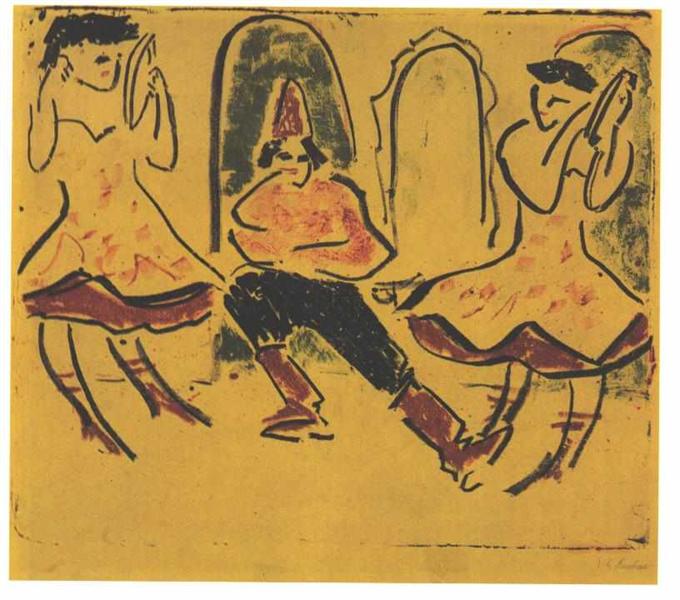Description
The work "Hungarian dance" (Hungary Dance) by Ernst Ludwig Kirchner is inscribed within one of the most vibrant and expressive stages of German Fauvism and expressionism. Kirchner, known for his mastery in capturing emotion through painting, presents in this work a deployment of energy and movement that evokes the rhythm of the dance it represents. Although the piece is not one of the best known of its vast production, it manifests itself as a clear exponent of its unique style, which combines a rich and vibrant palette with stylized and simplified shapes, characteristics of Fauvism.
The "Hungarian dance" composition focuses on a group of animated figures that seem to be in full action to dance, wrapping the viewer in its dynamics. The characters, endowed with an almost abstract air, intertwine with each other, creating a sense of community and effervescence. This approach to human interaction is fundamental in Kirchner's work, since it seeks to convey a visceral experience through shapes and color. The position of each figure, as well as the extension of their arms and legs, contrasts with the background, which, although it is not elaborated, plays a crucial role in the construction of the festive and cheerful atmosphere.
The colors in the paint are particularly notable. Kirchner uses a palette of intense and saturated tones, predominantly the yellows, oranges and blue that exudate vivacity and passion. These colors not only serve to capture attention, but also evoke emotion and celebrity. The choice of tones and their disposition in the work seem to dance along with the figures, reinforcing the notion of movement. The use of color, therefore, is not merely decorative, but becomes an almost narrative element that reinforces the theme of the dance.
At the stylistic level, "Hungarian dance" presents a clear example of Kirchner's interest in the culture and traditions of central Europe. His explorations on dance as a form of cultural expression reflect not only an appreciation for art, but also a search for identity that resonated at the time. The work can be considered a testimony of creative freedom and experimentation that characterized the avant -garde movements of the early twentieth century.
While you can find similarities with other works by Kirchner, such as "dance in the street" (1913), it is interesting to note how "Hungarian dance" is distinguished by its approach to the dynamics of the group and the celebration of the movement, instead of focus on the individual. This difference highlights Kirchner's ability to adapt and evolve within his own artistic language, always in search of new ways to capture the essence of his subjects.
In conclusion, "Hungarian dance" is a work that encapsulates the vitality and emotionality of the art of Ernst Ludwig Kirchner. Through its bold use of color and dynamic structure, painting not only represents dance as physical activity, but also invites viewers to experience fervor and camaraderie that this art can transmit. Kirchner, with his unique vision and innovative style, offers us a window to a cultural celebration that transcends time, inviting us to participate in this vibrant and emotional dance.
KUADROS ©, a famous paint on your wall.
Hand-made oil painting reproductions, with the quality of professional artists and the distinctive seal of KUADROS ©.
Art reproduction service with satisfaction guarantee. If you are not completely satisfied with the replica of your painting, we refund your money 100%.

